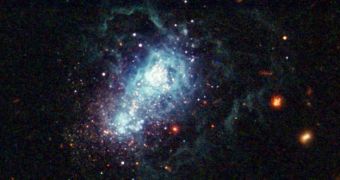A galaxy (from the Greek root galakt-, meaning "milk", a reference to our own Milky Way) is a massive, gravitationally bound space system consisting of stars, an interstellar medium of gas and dust, and dark matter.
Typical galaxies range from dwarfs with as few as ten million stars up to giants with one trillion stars, all orbiting a common center of mass. Galaxies can also contain many multiple star systems, star clusters and various interstellar clouds.
The majority of the most distant galaxies so far identified are very young, undergoing their first extremely vigorous bursts of star formation, says a team of UK, French and German astronomers.
Dr Malcolm Bremer of the University of Bristol, one of the scientists involved in the study: "Our new systematic survey shows that the majority of these distant galaxies are undergoing their first significant episodes of star formation at the epoch at which we observe them, thereby allowing us to directly observe this key moment in galaxy evolution."
The light that we see from these galaxies was emitted when the Universe was about 10 percent of its present age (or just over a billion years old). They are forming stars at a very high rate (up to a hundred times the rate at which our own Galaxy, the Milky Way, is currently forming stars). The duration of these intense star formation events is short astronomically speaking, comparable to the time it would take for a star to cross one of these galaxies (a few tens of millions of years).
This indicates that we are seeing in these galaxies one of their first major star formation events and are therefore watching the earliest stages of galaxy formation in the young Universe.
The team of astronomers discovered that the galaxies have a very high density of stars, the like of which is seen in only the centres of the most massive galaxies today. The stars that are forming in these young galaxies will end up in the biggest galaxies seen in the Universe today. Previous analysis of the light emitted by massive galaxies close to our own indirectly suggested that most stars in these galaxies formed just 1-2 billion years after the Big Bang.
The new results give direct evidence for this; the observed galaxies are captured in the first major phases of their star formation. The lead author of the study, Dr Aprajita Verma of Oxford University noted: "It is exciting to think that by analyzing the light from these very distant galaxies we can directly study the first star formation episodes that happened so soon after the Universe began".
The newly obtained data allowed the astronomers to determine further characteristics for the galaxies. In particular they were able to compare these very distant sources to star forming galaxies seen when the Universe was a billion years older. They found that the later galaxies were physically larger, more massive, more chemically enriched by heavier elements (created through nuclear fusion in the earliest stars) and had endured far longer episodes of star formation.
Finally, now the scientists are truly seeing direct evidence for the evolution of galaxies as the Universe ages.

 14 DAY TRIAL //
14 DAY TRIAL //